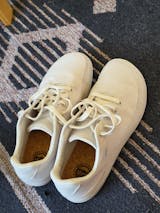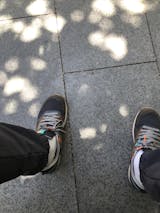Any seasoned runner has likely experienced a slew of injuries, both big and small – blisters, plantar fasciitis, shin splints – these can all sideline a runner for a few weeks, but the one injury runners truly fear are stress fractures.
This very common running injury can take weeks to heal, and may even require a boot or crutches. Stress fractures can recur if changes are not made to the runner’s training, nutrition, lifestyle, and footwear.
Understanding the causes, symptoms, and how footwear plays a role can help runners and other athletes avoid this dreaded injury.
WHAT ARE STRESS FRACTURES?
Stress fractures are tiny breaks or cracks in the bone, often caused by overuse during repetitive activities, such as running. They are fairly common injuries for runners and backpackers who carry heavy loads over long distances.
Over 80% of all stress fractures occur in the legs and feet, since they take the brunt of the force with each step.
Unlike a true broken bone, stress fractures develop over time, often as a result of athletes who start off with too much distance too soon.
Muscles need to adapt to the force of running and building slowly over time will allow those muscles to strengthen as needed to prevent injury.
SIGNS THAT YOU HAVE A STRESS FRACTURE
Stress fractures can sneak up on athletes, so it can be tricky to determine what is going on when you first start to feel some pain or tenderness.
Runners tend to get stress fractures in their feet, shins, heel, and hips. A few warning signs of stress fracture include:
- Sharp pain and swelling at the site of the fracture
- Tenderness to the touch
- Pain during activity, but not at rest
One way to test whether you may have a stress fracture is to hop on the foot that hurts a couple times. If you feel pain upon landing, then it could mean a stress fracture.
CAUSES OF STRESS FRACTURES
As mentioned in the section above, stress fractures are caused by repetitive motion from sports like long distance running, track and field, tennis, and basketball.
Without proper build up to the sport, then the added stress to the bones and muscles causes a situation where the likelihood of a stress fracture increases.
In addition to overuse, there are a number of other causes for stress fractures, such as:
IMPROPER NUTRITION
Fuelling appropriately before, during, and after intense workouts can play a role in stress fractures.
Lack of Vitamin D and low calcium levels are also common reasons for stress fractures, as inadequate levels cause weakened bones. Women especially are prone to osteoporosis.
Similarly, age factors into stress fractures, as bones naturally weaken as we age. Strength training can help immensely with maintaining bone strength into our golden years.
LACK OF CROSS TRAINING
Athletes who tend to stick to only one sport may find that they are more susceptible to stress fractures. Cross training helps build supporting muscles that may not be used during the athlete’s primary sport.
WEIGHT
Over or underweight athletes are at a higher risk for stress fractures, due to weakened bones as a result of being underweight or added stress to the bones from the additional weight.
HOW PROPER FOOTWEAR PREVENTS STRESS FRACTURES
Wearing proper footwear can do a lot to help prevent stress fractures. Zero-drop or minimalist shoes can help correct your form and encourage a forefoot strike compared to a heel strike.
Before you make the switch to minimalist shoes, just remember that you have to transition into the new footwear. Your feet and muscles will be used to running in traditional shoes and you’ll need to build some strength and stability in your feet before fully committing to the new footwear.
Ok, so how exactly do zero-drop and minimalist shoes help prevent stress fractures?
SUPPORT
Ill-fitting shoes are one of the biggest contributors to stress fractures. Because they don’t provide the proper support, the added stress to the bones in the foot, ankle, and shins puts the athlete at risk of stress fractures.
ALLOW NATURAL MOVEMENT OF THE FEET
Stress fractures can be caused by weakened muscles in your foot, and having an over-pronounced arch in your footwear can lead to a weakening of those muscles.
Shoes with a minimal drop and no arch can help foot muscles thrive because they allow the foot to behave as close to barefoot as possible. In minimalist shoes, the toes can splay fully thanks to the wide toe box, providing optimal support and balance.
REBUILD STRENGTH
Since stress fractures are caused by weakened bones and muscles, wearing minimalist footwear will retrain your feet back to their natural state. Conventional shoes teach our feet to rely on the shoe to correct imbalances caused by the shoe – it’s a vicious cycle!
Deformities and injuries caused by traditional shoes, such as bunions, shin splints, and plantar fasciitis can actually lead to stress fractures.
TREATING STRESS FRACTURES
After determining with your doctor that you do indeed have a stress fracture, you can work together to create a plan for recovery.
Healing time depends on how early you caught the injury and the severity of the injury. Most stress fractures generally take anywhere between six and eight weeks for full recovery.
Typical treatments include:
- RICE (Rest, Ice, Compression, Elevation)
- Cross training with a low impact activity, like cycling or swimming while you heal
- Wearing a boot or using crutches
As with any injury, prevention is the best way to avoid them in the first place! Wearing the proper footwear, building distance slowly, and properly fuelling your body will help keep you in top form for your favourite activities.

At bprimal, we work with shoemakers and brands who create natural footwear that are made to encourage better foot health by repairing the damage caused by long term use of modern shoes. These minimalist or healthy footwear alternatives ensure proper preservation of one’s natural foot shape and function thanks to their inclusion of all the design specifics needed to achieve optimal foot health. Some of these features include wide toe boxes, slim and flexible soles, and no heel elevation.
Our involvement and interaction with people who create and promote products that help individuals fix their foot problems has also inspired us to spread crucial awareness – relating to prioritising foot health as told by the experts – via our blog.
Learn More - check out bprimal educational articles here, and browse through the different brands and collections of natural footwear and foot health restoration products we carry.
DISCLAIMER:
The above content is for educational or informational purposes only and is not intended to replace or augment professional medical instruction, diagnosis, or treatment. Read the full Terms and Conditions & Disclaimer here.
























